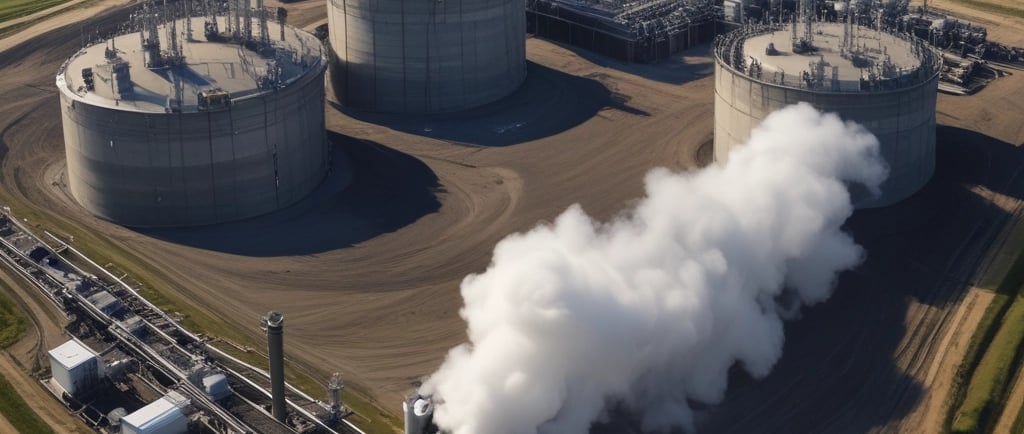ACT FOR THE PLANET, INVEST IN THE FUTURE
Is Carbon Capture Technology a Myth or Reality?
Explore the effectiveness of carbon capture and storage technology in addressing environmental concerns. Discover whether this innovative solution is a tangible reality or simply a myth in the fight against climate change.
Q2d
1/30/2025


Introduction to Carbon Capture and Storage (CCS) Technology
Carbon capture and storage (CCS) technology stands at the forefront of efforts to mitigate greenhouse gas emissions and combat climate change. With the urgency to reduce carbon dioxide levels in the atmosphere, the debate surrounding the effectiveness of CCS technology has intensified. This article explores the intricacies of CCS technology, delving into its mechanisms, evaluating its effectiveness, analyzing its benefits and challenges, and assessing its environmental, economic, and social impacts. By examining current applications and future potential, as well as the policy and regulatory considerations shaping the landscape, this article aims to provide a comprehensive overview of whether CCS is a myth or a reality in the quest for sustainable energy solutions.
Overview of CCS Technology
Carbon Capture and Storage (CCS) technology is like a superhero for tackling carbon emissions, capturing carbon dioxide produced from burning fossil fuels to prevent it from escaping into the atmosphere.
Importance of Addressing Carbon Emissions
With climate change knocking on our doorstep like an unwelcome neighbor, reducing carbon emissions is critical. CCS technology offers a promising solution to help combat this global issue.
1. Understanding the Mechanisms of Carbon Capture and Storage
Carbon Capture Processes
Picture this: CCS technology uses various methods to trap carbon dioxide at its source, whether it's a power plant or an industrial facility. It's like catching smoke before it billows out into the air.
Transportation and Storage of Captured Carbon
Once the carbon dioxide is captured, it's like sending it on a one-way trip to an underground storage space, where it's stored safely away from the atmosphere, almost like carbon house arrest.
2. Evaluating the Effectiveness of CCS Technology
Measurement of Carbon Capture Efficiency
Think of it as a report card for CCS technology – scientists measure how much carbon dioxide it captures versus how much slips through its grasp. Spoiler alert: it's pretty good at its job.
Comparative Analysis with Other Carbon Reduction Methods
CCS technology isn't the only player in the carbon reduction game. It competes with other methods like renewable energy sources, but when it comes to capturing carbon, CCS holds its own like a boss.
3. Benefits and Challenges of Implementing CCS
Environmental Benefits of CCS
By keeping carbon dioxide out of the atmosphere, CCS technology helps reduce the impact of climate change, like a shield protecting the Earth from the heat-trapping effects of excess carbon emissions.
Technical and Economic Challenges
Implementing CCS technology isn't all rainbows and sunshine. It faces challenges like cost and technical feasibility, but hey, nothing worth doing is ever easy, right?
4. Current Applications and Future Potential of CCS
Existing CCS Projects Worldwide
Let's take a peek at what's already out there in the world of carbon capture and storage. These projects are like the brave pioneers of the CCS realm, showing us what's possible and giving us hope for a greener future.
Innovations and Advancements in CCS Technology
It's not all old school in the land of carbon capture and storage. Innovators are working tirelessly to push the boundaries of CCS technology. From fancy new materials to groundbreaking techniques, the future of CCS is looking pretty darn exciting.
5. Environmental, Economic, and Social Impacts of CCS
Environmental Impacts of CCS Deployment
We can't talk about CCS without considering its impact on Mother Nature. Are we really doing her a solid with this technology, or are we just adding more complications to an already sticky situation?
Economic Viability and Job Creation Potential
Let's get down to the nitty-gritty - how does CCS stack up in the big bad world of money? Is it a financial black hole, or could it be the golden ticket to economic prosperity? And hey, what about all those jobs we keep hearing about?
6. Policy and Regulatory Considerations for CCS Deployment
Current Policy Landscape for CCS
You didn't think we could chat about CCS without throwing some policy jargon into the mix, did you? Strap in for a whirlwind tour of the current rules and regulations governing carbon capture and storage.
Regulatory Frameworks and Incentives for CCS Implementation
It's not just about the rules - sometimes you need a juicy incentive to get the ball rolling. What kind of carrots are being dangled in front of businesses to make them jump on the CCS bandwagon, and are they working?In conclusion, carbon capture and storage technology holds promise as a key solution in reducing carbon emissions and combating climate change. While challenges remain, the potential benefits of CCS are significant in transitioning towards a more sustainable energy future. By continuing to innovate, invest, and collaborate on CCS initiatives, we can move closer to realizing its full potential and making a tangible impact in the global fight against climate change.
Frequently asked questions
1. Is carbon capture and storage technology proven to be effective in reducing carbon emissions?
Carbon capture and storage (CCS) technology shows promise for reducing CO2 emissions from industrial and energy sources, capable of capturing up to 90% of emissions when implemented effectively. Despite advancements, challenges like high costs, infrastructure needs, and regulatory uncertainties hinder broader use. Successful CCS outcomes depend on local conditions, such as geological suitability and government support.
CCS should complement other climate strategies, including renewable energy and energy efficiency. While crucial for emission reduction, it cannot work in isolation; policies to reduce fossil fuel reliance are vital for sustainable emission cuts.
As climate change urgency grows, efforts to raise public awareness, support research, and improve CCS economics are critical. Collaboration among governments, industries, and researchers is essential to fully realize CCS's potential in meeting carbon reduction targets.
2. What are some of the main challenges hindering the widespread implementation of CCS technology?
Key challenges to widespread CCS technology adoption include high costs for CO2 capture, transport, and storage, which deter investors. A lack of supportive government policies and public concerns about underground CO2 safety further hinder progress. Complex regulatory frameworks create uncertainty for stakeholders, and technical advancements are needed to enhance capture efficiency. Additionally, inadequate CO2 transport networks complicate logistics, especially when storage sites are far from emission sources. These issues slow CCS implementation despite its potential to reduce greenhouse gas emissions significantly.
3. How does carbon capture and storage compare to other carbon reduction methods, such as renewable energy sources?
Carbon capture and storage (CCS) is a key technology aimed at reducing climate change by capturing carbon dioxide emissions from fossil fuel power plants and storing them underground. While CCS can help mitigate emissions, its effectiveness and scalability are limited compared to renewable energy sources like solar, wind, and hydro, which provide clean energy without CO2 emissions. Transitioning to renewables reduces fossil fuel dependence and fosters sustainable systems, while CCS serves primarily as a temporary fix within the fossil fuel framework.
The costs associated with each method vary significantly. Renewable energy requires high initial investments, but long-term operational costs decrease due to zero fuel expenses. CCS, on the other hand, remains costly in terms of capture technology and infrastructure needed for CO2 transport and storage, making widespread adoption challenging, particularly in developing countries.
Renewable energy's scalability and accessibility surpass that of CCS, with solar and wind energy applicable across different settings, while CCS is limited to regions with suitable geological formations. Additionally, concerns over the long-term safety of carbon storage create uncertainties absent in renewable energy.
In conclusion, CCS should be considered a supplementary measure in the fight against greenhouse gas emissions. Emphasizing renewable energy development can better address emission reductions, promote sustainability, and enhance energy resilience, making it a more effective strategy against climate change in the long term.
4. What role do government policies and regulations play in the adoption and deployment of CCS technology?
Government policies and regulations are crucial for the development of Carbon Capture and Storage (CCS) technology, influencing its adoption and implementation. Supportive policies can offer financial incentives like tax credits or grants, reducing economic barriers for companies. For instance, the 45Q tax credit in the U.S. has significantly encouraged CCS investments by providing credits for stored carbon dioxide.
Regulatory frameworks provide the legal certainty needed for long-term CCS investments. Clear guidelines on CO2 storage, including site selection and monitoring, can promote partnerships between public and private sectors. Addressing environmental and public health concerns in regulations builds community trust in CCS projects.
Additionally, government initiatives can boost research and development through funding and collaborations with private entities. By emphasizing CCS in national climate plans, governments can drive innovation and decrease costs. International agreements for emissions reduction also support CCS deployment as a climate change solution.
In summary, the success of CCS technology relies on well-aligned policies and regulations that enhance financial viability, encourage innovation, engage the public, and establish a solid legal framework.
Ecology
Promote initiatives for a sustainable future.
OPPORTUNITIES
Durability
contact@ecodurableplus.com
+228 98 74 89 89
© 2024. Q2d -All rights reserved.


Blog
